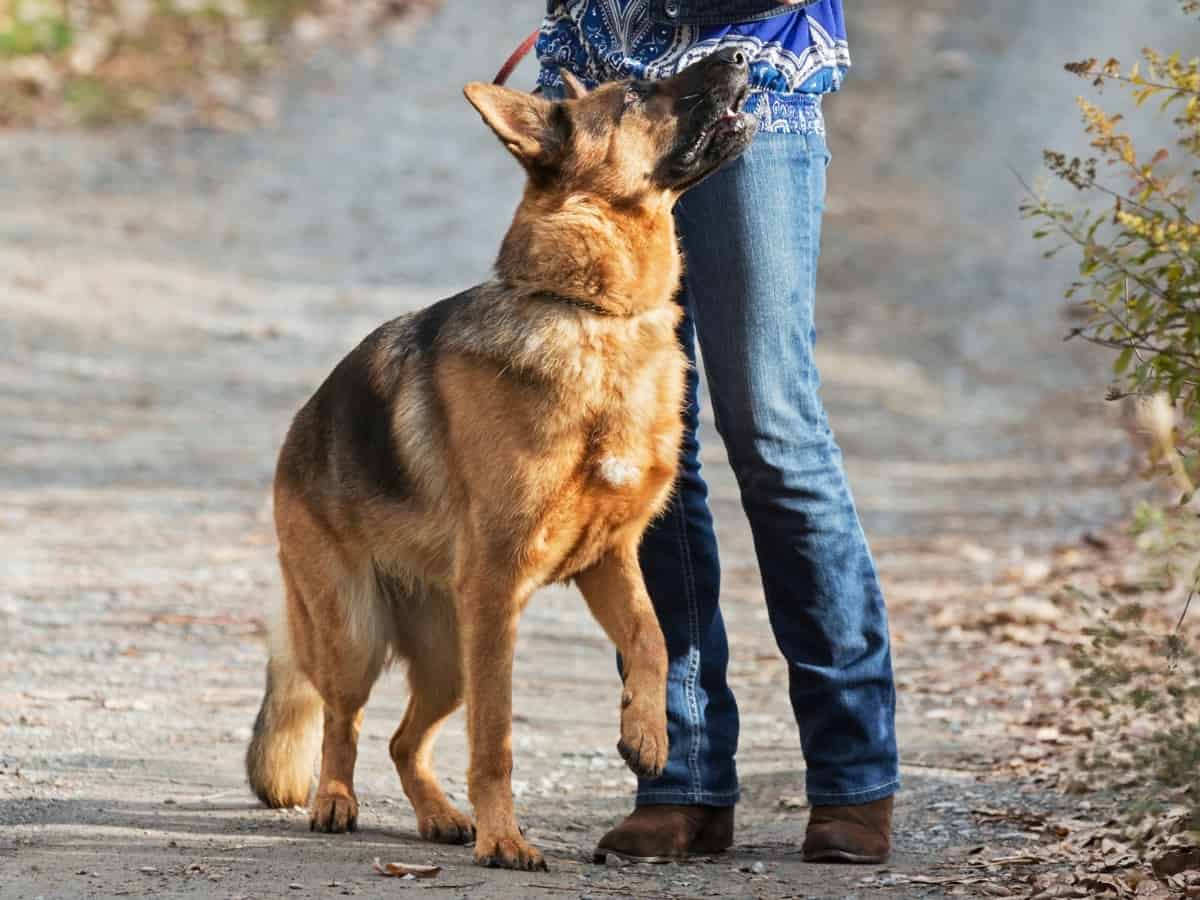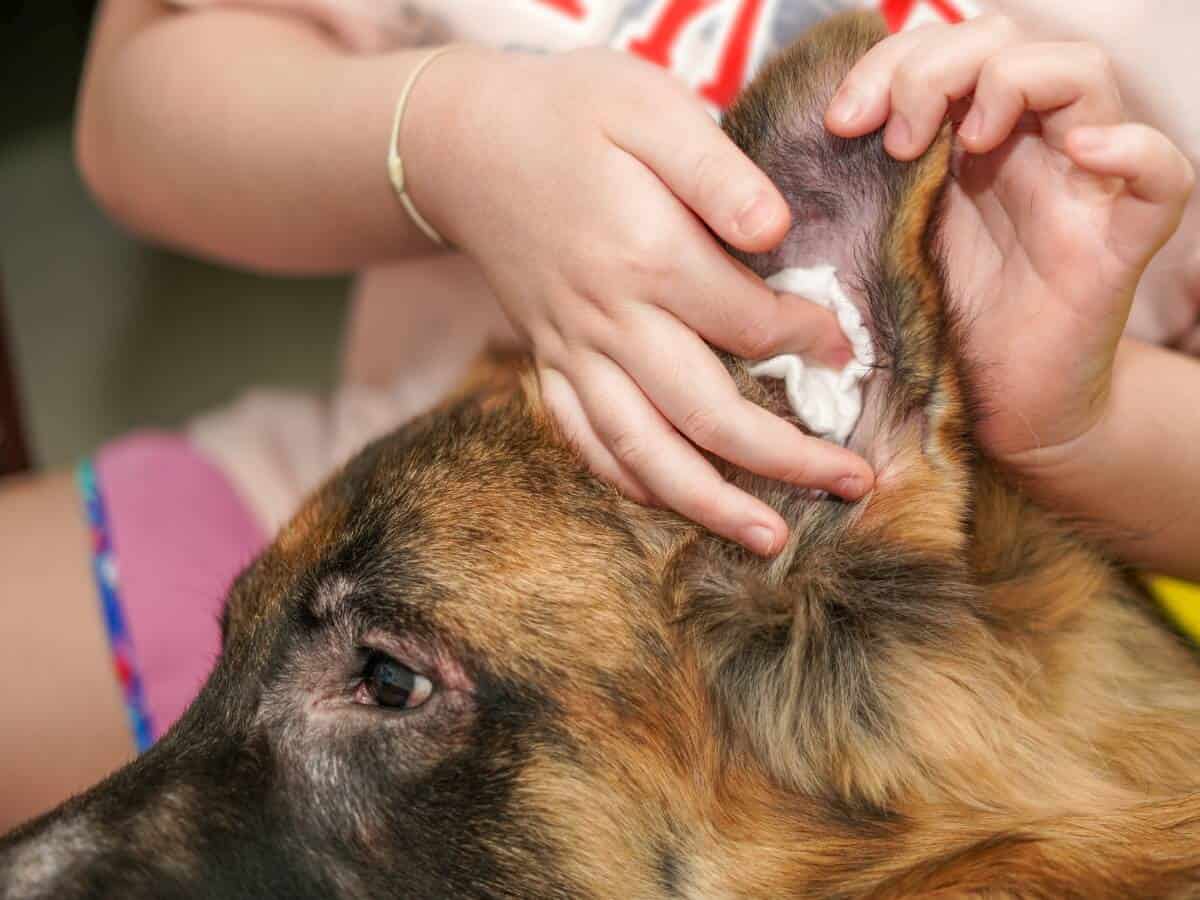As a devoted German Shepherd owner, I’ve always been fascinated by the subtle yet expressive body language of these magnificent dogs. Understanding why your German Shepherd puts their ears back is not just about satisfying curiosity but deepening the bond you share with your loyal companion.
German Shepherds put their ears back to communicate emotions like relaxation, submission, or affection, especially during social interactions. This gesture can also indicate fear, anxiety, or aggression in stressful situations. Context and accompanying body language are key to interpreting this behavior accurately.
My journey through dog training, backed by extensive research and real-life experiences, has equipped me with valuable insights into the nuances of German Shepherd communication, which I’m eager to share with you.
Let’s delve into the fascinating world of canine ear movements, focusing on the compelling reasons behind why German Shepherds put their ears back.
Key Takeaways:
- German Shepherds use ear position to communicate emotions and intentions.
- Observing your dog’s ear language can help you understand their needs and well-being.
- Regular ear care and management can promote your German Shepherd’s overall health.

Understanding German Shepherd Ear Language
Basics of Canine Communication
Just like humans, dogs too have their own language that they use to communicate with each other and with their owners. Canine communication is a combination of body language, vocalization, and scent.
One critical aspect of their body language is the position of their ears. As a German Shepherd owner, understanding your dog’s ear language can help you better communicate with them and anticipate their needs or reactions.
Significance of Ear Movements
The ear movements of your German Shepherd can provide valuable insights into their emotions and intentions.
Unlike other breeds with floppy ears, German Shepherds have pointy, erect ears which make it easier to observe their ear positions. Here are some common ear positions and what they might signify:
- Ears forward: Your dog is alert and focused on something in front of them.
- Ears back: Your dog is feeling relaxed, submissive, or sometimes aggressive.
Ears Back: Interpreting the Position
When your German Shepherd puts their ears back, it’s essential to observe their overall body language to understand the context.
If their body posture is relaxed and their tail is wagging, it indicates that they are in a submissive or friendly mood.
However, if they are growling, baring their teeth, or have a rigid body posture with their ears back, it could be a sign of aggression or fear.
Comparison with Other Breeds
While ear language is generally consistent across dog breeds, pointy, and floppy ears can make a difference in interpreting their communication.
Breeds with floppy ears may not convey their emotions as distinctly through ear movements, making it difficult to read their intentions.
On the other hand, German Shepherd’s erect ears make it easier for you to understand their ear language and communicate effectively with them.
By paying attention to your German Shepherd’s ear positions, you can better understand their emotions, needs, and desires.

Common Emotions Expressed by Ear Position
German Shepherds, like other dogs, use their ears as a primary means of communication, expressing a wide range of emotions. In this section, you’ll learn about the emotions conveyed through their ear positions.
1. Submissiveness and Anxiety
When your German Shepherd is feeling submissive or anxious, they may pull their ears back or flatten them against their head. This position conveys a non-threatening posture and may be used during social interactions with other dogs or humans.
2. Fear and Uncertainty
Fear and uncertainty can cause your German Shepherd’s ears to be pulled back tightly against their head.
The eyes may widen, and the body posture can be hunched or cowering. This ear position is similar to submissiveness but exhibits a stronger emotional response.
3. Excitement and Arousal
Excitement and arousal can be expressed through a variety of ear positions. In most cases, the ears will be up and forward, indicating heightened focus and engagement.
The ear position may also be paired with obvious physical energy, such as wagging tails and eager facial expressions.
4. Relaxation and Contentment
When your German Shepherd is relaxed and content, their ears will usually be in a neutral position. This means that the ears are neither pulled back nor standing straight up.
The ear position combined with relaxed facial expressions will depict that the dog is feeling calm and at ease.
5. Alertness and Curiosity
If your dog is alert or curious, their ears will typically be erect and forward-facing. This position allows them to better capture sounds and signals from their environment.
You may notice this when your German Shepherd is watching or listening to something intently.
6. Protectiveness and Aggression
When a German Shepherd senses danger or feels the need to protect, their ears may be upright and slightly angled forward.
In this position, the dog may also exhibit other body language cues such as stiffened posture, raised hackles, and tense facial expressions.
Physical and Health Factors Influencing Ear Positions
The Role of Cartilage and Teething

As your German Shepherd puppy grows, their ear cartilage begins to strengthen. During the teething period, your puppy may have temporarily floppy ears.
This is because the calcium that usually strengthens the ear cartilage is redirected towards the developing teeth.
Don’t worry, this is normal, and once teething is complete, the calcium levels will balance out, and your German Shepherd’s ears should stand up again.
Ear Infections and Foreign Objects
Ear infections or foreign objects in your German Shepherd’s ear canals can cause them to hold their ears back. It’s essential to monitor your dog’s ear health and consult a vet if you suspect any problems.
Regular cleaning can help prevent infections and keep the ear canals clear. It would be best if you also kept an eye out for signs of discomfort, such as scratching or head shaking, which could indicate an infection or a foreign object in the ear.
Pain and Discomfort
If your German Shepherd is experiencing pain or discomfort, they might hold their ears back. This could be due to an injury, illness, or even anxiety.
Pay attention to your dog’s body language and behavior, and if you notice any changes, consult your vet to address any possible health issues.
Impact of Genetics on Ear Shape
Genetics plays a role in determining the shape and position of your German Shepherd’s ears. While most German Shepherds have naturally pointy ears, some may have floppy ears due to their genetic makeup.
If your dog’s ears remain floppy beyond their teething phase, it’s possible that genetics are at play. However, as long as your dog is healthy and happy, there’s no reason to be concerned about the position of their ears.
Behavioral Implications of German Shepherd Ear Movement
Training and Behavioral Correction
When training your German Shepherd, it is crucial to observe their ear movements, as this can provide insight into their level of understanding and compliance.
For example, ears that are pricked forward indicate that your dog is paying close attention to their trainer or the given command.
Conversely, ears that are pinned back may signal uncertainty or resistance to the training process. Adjusting your training methods and reinforcement techniques based on these signals can vastly improve your dog’s ability to learn and correct their behavior.

Canine Communication with Other Dogs
In addition to their function in training, German Shepherds use their ears to communicate with other dogs.
When interacting with canine pals, observe your dog’s ear movements to understand their canine communications.
Ears that are relaxed or slightly tilted back convey friendliness or playfulness, whereas ears that are erect and forward-oriented indicate a more assertive or dominant stance.
Owner-Pet Relationship Dynamics
Your German Shepherd’s ear movements can also strengthen your bond with them by helping you interpret their emotions.
For instance, when your dog’s ears are pricked forward, they are expressing loyalty, affection, and a desire for your attention.
On the other hand, ears held back may indicate that your pet is seeking reassurance or comfort from you.
Acknowledging these ear movements and responding appropriately can cultivate a deeper connection between you and your beloved pet.
Stress and Separation Anxiety Responses
German Shepherds, like all dogs, can experience stress and separation anxiety. Ear movements can serve as a means to identify these emotional states.
Ears that are pinned back, coupled with other body language cues such as tail tucking and tense posture, can signify stress or anxiety.
If your dog exhibits these behaviors consistently, it is essential to address their emotional well-being, as prolonged stress can adversely affect their overall health.
Consult with a professional behaviorist or veterinarian to develop strategies for managing your dog’s anxiety and stress levels.
German Shepherd Ear Care and Management
Regular Veterinary Checks
To maintain your German Shepherd’s ear health, you must schedule regular veterinary checks. This will allow your vet to monitor any changes in their ears and address any potential issues before they become severe.
Ear Cleaning and Maintenance
Careful and consistent ear cleaning is a fundamental aspect of German Shepherd ear care. Remember to clean around your dog’s ears, but avoid probing into the ear canal.
Utilize an appropriate ear-cleaning solution and soft cotton balls to gently remove debris from your dog’s ears. Consistent cleaning will prevent the buildup of bacteria and reduce the risk of ear infections.

Taping and Support for Erect Ears
As your German Shepherd grows, their ears will begin to stand erect. This process could be supported by taping when needed. Taping should only be done under the guidance of a professional.
Consult your vet for recommendations on suitable taping methods for your dog to prevent unnecessary discomfort or pain.
| Stage of Growth | Ear Status | Possible Taping |
|---|---|---|
| Puppy | Soft and flopped-down | Not recommended |
| Teething Stage | Ears may go up and down | Consult your vet |
| Post-teething | Ears not standing on their own | Discuss taping options with your vet |
Observing Changes and Timely Interventions
Keeping a close eye on your German Shepherd’s ears for any changes is crucial in ensuring their ear health. Observe their ears for any signs of discomfort, such as excessive scratching, discharge, or unusual odor. These could be indicative of ear infections or other health issues.
If you notice abnormalities or suspect a problem, don’t hesitate to contact your vet promptly. Timely interventions can prevent more severe problems and help your German Shepherd maintain overall ear health.
FAQs
Why does my German Shepherd put his ears back upon seeing me?
Your German Shepherd putting his ears back upon seeing you is typically a sign of affection and excitement. It’s a friendly gesture, often accompanied by other signs of happiness like a wagging tail or a playful stance.
Why does my German Shepherd put his ears back when I pet him?
German Shepherds, known for their expressive ears, often put them back when being petted as a sign of relaxation and trust. This gesture indicates they enjoy the petting and feel safe and comfortable in your presence.
How do I recognize if my German Shepherd is experiencing ear problems?
If your German Shepherd is experiencing ear problems, you might notice them frequently shaking their head or scratching at their ears. In some cases, you may see redness, swelling, or discharge. If you observe these symptoms, consult your veterinarian to diagnose and treat any potential ear issues properly.
Is it normal for German Shepherd puppies to have ears curling back?
Yes, it is quite normal for German Shepherd puppies to have ears curling back in the early months. As the puppy grows, their ears will go through stages of folding and unfolding before finally standing upright.
This is due to the developing cartilage that supports the ears. Generally, you can expect the ears to stand on their own by the time the puppy is six months old.
In what situations might a German Shepherd have its ears pinned back and exhibit panting behavior?
A German Shepherd might have its ears pinned back and exhibit panting behavior when stressed, fearful, or anxious. This combined response allows the dog to cool down in tense situations while also communicating their emotional state to others.
Again, observing additional body language cues will help you determine the cause of the behavior.
Can the position of a German Shepherd’s ears indicate happiness?
Yes, certain ear positions can indicate happiness in a German Shepherd. Typically, when a German Shepherd is happy, their ears will be in a relaxed, upright position, and their face will appear relaxed and friendly.
As always, it is essential to consider other body language aspects, like a wagging tail or a playful stance, to confirm your dog’s happiness.
What are the typical ear positions and their meanings for German Shepherds?
German Shepherds communicate a range of emotions through their ear positions:
- Upright ears: Alertness or curiosity.
- Ears held back: Submissiveness, nervousness, or affection.
- Ears pinned back and panting: Fear, anxiety, or stress.
- Relaxed, upright ears: Contentment or happiness.
Understanding why your German Shepherd puts its ears back is more than just a curiosity – it’s vital to responsible and empathetic pet ownership.
It’s crucial to remember that ear positions should be analyzed along with other body language cues to get a complete understanding of your German Shepherd’s emotions.





